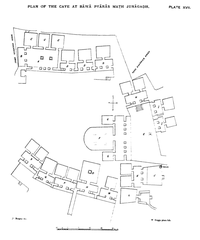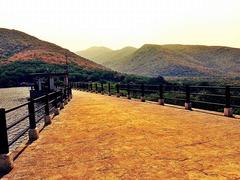Jumma Masjid and Cannons Neelam and Kadanal in Junagadh: Complete Visitor Guide
Date: 04/07/2025
Introduction
Set within the formidable Uparkot Fort in Junagadh, Gujarat, the Jumma Masjid and the legendary cannons—Neelam and Kadanal—stand as enduring symbols of the region’s layered history and multicultural heritage. Jumma Masjid, constructed in 1423 CE under Sultan Ahmed Shah, is a remarkable example of Indo-Islamic architecture, harmoniously blending Hindu and Jain motifs. Meanwhile, the Neelam and Kadanal cannons, perched on the fort’s ramparts, narrate stories of military ingenuity, global exchange, and local resilience (Tourism Club Junagadh; Gujarat Tourism).
This comprehensive guide covers historical context, architectural features, visitor information, ticketing, accessibility, travel tips, and cultural insights—helping you experience the best of Junagadh’s heritage sites (TripXL; TripCrafters).
Table of Contents
- Historical Background
- Architectural Features of Jumma Masjid
- Cultural and Religious Significance
- The Neelam and Kadanal Cannons: History & Features
- Visiting Information: Hours, Tickets, Accessibility
- Guided Tours and Interpretation
- Photography Tips and Best Spots
- Visitor Facilities and Amenities
- Travel Tips and Nearby Attractions
- Dress Code and Etiquette
- Special Events and Festivals
- FAQs
- Conclusion
- References
Historical Background
Jumma Masjid
Located within Uparkot Fort—whose origins trace back over 2,300 years—Jumma Masjid was built in 1423 CE as the principal mosque for Sultan Ahmed Shah’s court. The mosque’s position within a fort that has witnessed Mauryan, Chudasama, and Sultanate rule highlights its role as both a religious and strategic landmark (Tourism Club Junagadh).
Uparkot Fort Cannons
The fort’s cannons, Neelam and Kadanal, reflect Junagadh’s military significance and cosmopolitan connections. Neelam, cast in Egypt in 1531 CE, arrived in Junagadh after the Turkish fleet’s defeat at Diu. Kadanal, featuring unique metallurgical craftsmanship, was likely forged in the Indian subcontinent and later restored (Uparkot Fort Official; Gujarat Darshan Guide).
Architectural Features of Jumma Masjid
- Courtyard and Structure: The mosque features a vast marble-paved courtyard and a prayer hall upheld by 260 intricately carved pillars and topped with 15 domes of varied heights (Tourism Club Junagadh).
- Fusion of Styles: Lotus-like domes hint at Jain influences, while the geometric and floral patterns on pillars reflect Hindu temple artistry. The mosque’s ‘shaking minarets’—partially damaged in an 1819 earthquake—demonstrate advanced medieval engineering (Gujarat Tourism).
- Materials: Locally sourced sandstone and marble ensure both durability and comfort, keeping interiors cool. Wooden screens (jalis) provide ventilation and privacy.
Cultural and Religious Significance
Jumma Masjid remains a vital spiritual center for Junagadh’s Sunni Muslim community, hosting daily prayers and major congregational events. Its architecture and continued use reflect centuries of religious coexistence and artistic synthesis. Mausoleums of Sultan Ahmed Shah and queens (Rani no Hajiro) are located nearby, further enriching its historical environment (Gujarat Tourism).
The Neelam and Kadanal Cannons: History & Features
Neelam Cannon
- Origin: Cast in Egypt in 1531 CE and brought to Junagadh after the defeat of the Turkish navy by the Portuguese at Diu (Gujarat Darshan Guide).
- Features: Bronze alloy barrel with Arabic inscriptions and significant size, symbolizing military prowess and cosmopolitan exchange (Uparkot Fort Before & After).
Kadanal Cannon
- Design: Measures 3.8 meters in length, decorated with ten sets of five rings, and made from a unique five-metal alloy (Uparkot Fort Before & After).
- Restoration: Mounted on a custom cast iron stand, the cannon is a testament to both ancient metallurgical skill and modern preservation efforts.
Symbolism
Both cannons are not only military artifacts but also symbols of power transitions and Junagadh’s role in regional and global histories (Uparkot Fort Official).
Visiting Information
Hours and Tickets
- Jumma Masjid: Open daily, typically from 6:00 AM to 8:00 PM. No entry fee; donations are welcome. Timings may vary during festivals or special events.
- Uparkot Fort & Cannons: Open daily from 6:00 AM to 6:00 PM.
- Tickets: ₹5 for Indian citizens, ₹100 for foreign tourists. Children under 5 enter free. Additional camera/video charges may apply (The Lion Lodge).
Accessibility
- The fort and mosque complex are accessible by local transport, with parking available near the entrance.
- Some areas have uneven terrain and steps; basic accessibility is provided, but visitors with mobility challenges should take precautions.
Guided Tours and Interpretation
Local guides at Uparkot Fort offer tours in multiple languages, covering the mosque, cannons, and fort history. Audio guides may be available. Informational signage enriches the experience (TripCrafters).
Photography Tips and Best Spots
- Allowed: Photography is permitted in the fort and mosque courtyard; avoid flash inside prayer halls.
- Best Views: Capture the mosque’s carved pillars, domes, and the panoramic views from the fort ramparts overlooking Junagadh and Girnar Hill.
- Respect: Seek permission before photographing worshippers or during religious ceremonies.
Visitor Facilities and Amenities
- Restrooms: Available near the main entrance.
- Food: Local eateries and vendors sell Gujarati snacks and bottled water.
- Shops: Handicraft stalls offer souvenirs and religious items.
- Parking: Ample and mostly free, with nominal charges during peak seasons.
Travel Tips and Nearby Attractions
- Best Season: October to March for pleasant weather.
- Other Sights: Buddhist caves, Navghan Kuvo and Adi Kadi Vav stepwells, Mahabat Maqbara, Darbar Hall Museum, and Girnar Hill.
- Safety: Security personnel and CCTV monitoring are provided; first aid and lost-and-found counters are available.
Dress Code and Etiquette
- Modest attire is mandatory: cover shoulders and knees; women should cover hair (scarves available at the entrance).
- Shoes must be removed before entering prayer halls.
- Maintain silence during prayers and respect all religious practices.
Special Events and Festivals
Major Islamic festivals such as Eid and Ramadan see the mosque bustling with special prayers and community meals. Urs festivals include devotional music and charitable events, giving visitors a glimpse of local traditions and hospitality.
Frequently Asked Questions (FAQs)
Q: What are the Jumma Masjid visiting hours?
A: Typically 6:00 AM to 8:00 PM; closed to tourists during Friday prayers (12:00 PM–2:00 PM).
Q: Is there an entry fee?
A: Entry to the mosque is free; Uparkot Fort charges a nominal fee.
Q: Are guided tours available?
A: Yes, local guides and audio guides are available at the entrance.
Q: Is photography allowed?
A: Permitted in open areas; avoid flash and photographing worshippers during prayers.
Q: Is the site accessible for people with disabilities?
A: The main courtyard is generally accessible, but some historic areas have steps and uneven ground.
Conclusion
A visit to Jumma Masjid and the Neelam and Kadanal cannons within Uparkot Fort is a journey through Junagadh’s vibrant past, uniting religious devotion, artistic brilliance, and military valor. These monuments offer an immersive encounter with Gujarat’s diverse heritage. Plan your visit to coincide with cooler months and local festivals to experience the full cultural vibrancy of Junagadh. For updates, travel tips, and exclusive content, download the Audiala app and follow official tourism channels.

